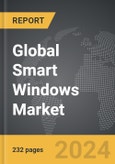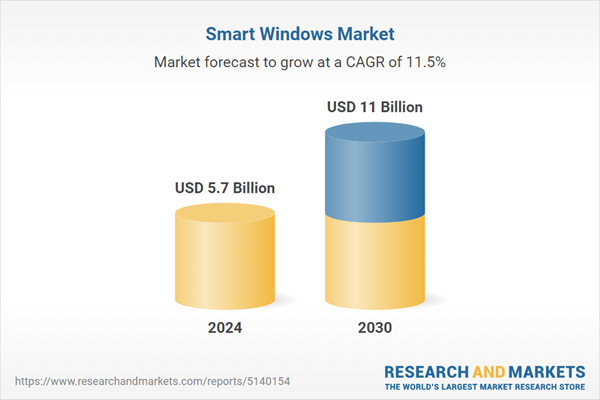The global market for Smart Windows was valued at US$5.7 Billion in 2024 and is projected to reach US$11.0 Billion by 2030, growing at a CAGR of 11.5% from 2024 to 2030. This comprehensive report provides an in-depth analysis of market trends, drivers, and forecasts, helping you make informed business decisions. The report includes the most recent global tariff developments and how they impact the Smart Windows market.
Segments: Window Type (OLED Glass Windows, Other Window Types); Technology (Suspended Particle Devices (SPD) Technology, Electrochromic Technology, Polymer Dispersed Liquid Crystal (PDLC) Technology, Other Technologies).
Geographic Regions/Countries: World; USA; Canada; Japan; China; Europe; France; Germany; Italy; UK; Rest of Europe; Asia-Pacific; Rest of World.
The analysts continuously track trade developments worldwide, drawing insights from leading global economists and over 200 industry and policy institutions, including think tanks, trade organizations, and national economic advisory bodies. This intelligence is integrated into forecasting models to provide timely, data-driven analysis of emerging risks and opportunities.
Global Smart Windows Market - Key Trends & Drivers Summarized
What Are Smart Windows and How Are They Transforming Modern Architecture?
Smart windows are advanced glazing systems equipped with technologies that enable them to modulate light, heat, and energy transmission dynamically. These windows are designed to optimize energy efficiency, improve occupant comfort, and enhance building aesthetics. Unlike conventional windows, smart windows can adapt to environmental conditions, such as sunlight intensity, through electrochromic, photochromic, thermochromic, or liquid crystal technologies. Their ability to reduce heating, cooling, and lighting costs has made them integral to sustainable building designs. Moreover, the growing emphasis on green building certifications and energy-saving solutions has driven the adoption of smart windows across residential, commercial, and automotive applications.How Are Technological Innovations Driving Smart Window Capabilities?
Technological advancements have significantly expanded the functionalities and appeal of smart windows. Electrochromic technology, one of the most prevalent methods, enables precise control over tint levels, allowing windows to transition seamlessly from transparent to opaque. Integration of Internet of Things (IoT) technologies has enhanced automation and user control, enabling smart windows to be managed via smartphone apps or integrated into building management systems. Recent developments in nanotechnology have further improved the efficiency and durability of smart window coatings, while advances in photovoltaic smart windows allow them to generate electricity in addition to controlling light. Additionally, the emergence of transparent OLED displays embedded in smart windows has opened up possibilities for dynamic signage and interactive interfaces.Who Are the Major End-Users and What Applications Are Driving Market Growth?
The smart windows market serves a diverse array of end-users, including building owners, automotive manufacturers, and public infrastructure developers. In the construction sector, smart windows are becoming an essential feature in modern skyscrapers, energy-efficient residential buildings, and smart homes. Automotive applications are also on the rise, with smart windows being used for glare reduction, privacy enhancement, and improved passenger comfort. The transportation sector, including aviation and railways, is adopting smart windows to create more energy-efficient and comfortable cabin environments. Furthermore, there is growing interest in leveraging smart windows for healthcare facilities, where they can improve patient recovery environments by providing natural light and privacy control.What Are the Key Drivers Behind the Growing Demand for Smart Windows?
The growth in the smart windows market is driven by several factors, including advancements in materials science, shifts in consumer preferences, and regulatory incentives. Increasing concerns about energy efficiency and carbon emissions have accelerated the adoption of smart windows in green building initiatives. Rising demand for connected and smart home solutions has made these windows an attractive option for homeowners. The automotive sector’s focus on enhancing passenger comfort and vehicle energy efficiency is another major driver. Additionally, government policies promoting energy-efficient technologies and subsidies for green construction have bolstered market growth. Consumer awareness of sustainability and technological innovations, such as cost-effective manufacturing processes and multifunctional coatings, are further catalyzing demand for smart windows across various sectors.Report Scope
The report analyzes the Smart Windows market, presented in terms of units. The analysis covers the key segments and geographic regions outlined below.Segments: Window Type (OLED Glass Windows, Other Window Types); Technology (Suspended Particle Devices (SPD) Technology, Electrochromic Technology, Polymer Dispersed Liquid Crystal (PDLC) Technology, Other Technologies).
Geographic Regions/Countries: World; USA; Canada; Japan; China; Europe; France; Germany; Italy; UK; Rest of Europe; Asia-Pacific; Rest of World.
Key Insights:
- Market Growth: Understand the significant growth trajectory of the OLED Glass Windows segment, which is expected to reach US$5.5 Billion by 2030 with a CAGR of a 9.9%. The Other Window Types segment is also set to grow at 13.3% CAGR over the analysis period.
- Regional Analysis: Gain insights into the U.S. market, valued at $2.4 Billion in 2024, and China, forecasted to grow at an impressive 13.5% CAGR to reach $1.2 Billion by 2030. Discover growth trends in other key regions, including Japan, Canada, Germany, and the Asia-Pacific.
Why You Should Buy This Report:
- Detailed Market Analysis: Access a thorough analysis of the Global Smart Windows Market, covering all major geographic regions and market segments.
- Competitive Insights: Get an overview of the competitive landscape, including the market presence of major players across different geographies.
- Future Trends and Drivers: Understand the key trends and drivers shaping the future of the Global Smart Windows Market.
- Actionable Insights: Benefit from actionable insights that can help you identify new revenue opportunities and make strategic business decisions.
Key Questions Answered:
- How is the Global Smart Windows Market expected to evolve by 2030?
- What are the main drivers and restraints affecting the market?
- Which market segments will grow the most over the forecast period?
- How will market shares for different regions and segments change by 2030?
- Who are the leading players in the market, and what are their prospects?
Report Features:
- Comprehensive Market Data: Independent analysis of annual sales and market forecasts in US$ Million from 2024 to 2030.
- In-Depth Regional Analysis: Detailed insights into key markets, including the U.S., China, Japan, Canada, Europe, Asia-Pacific, Latin America, Middle East, and Africa.
- Company Profiles: Coverage of players such as AGC, Inc., ChromoGenics AB, Diamond Glass, Eastman Chemical Company, Gentex Corporation and more.
- Complimentary Updates: Receive free report updates for one year to keep you informed of the latest market developments.
Some of the 65 companies featured in this Smart Windows market report include:
- AGC, Inc.
- ChromoGenics AB
- Diamond Glass
- Eastman Chemical Company
- Gentex Corporation
- Guardian Glass
- Innovative Glass Corporation
- Merck KGaA
- NSG Group
- Onyx Solar Group LLC
- Polytronix, Inc.
- PPG Aerospace
- RavenWindow
- SageGlass
- Scienstry, Inc.
- Smart Glass International Ltd.
- Smart Windows Colorado
- View, Inc.
- Vista Window Company
Tariff Impact Analysis: Key Insights for 2025
Global tariff negotiations across 180+ countries are reshaping supply chains, costs, and competitiveness. This report reflects the latest developments as of April 2025 and incorporates forward-looking insights into the market outlook.The analysts continuously track trade developments worldwide, drawing insights from leading global economists and over 200 industry and policy institutions, including think tanks, trade organizations, and national economic advisory bodies. This intelligence is integrated into forecasting models to provide timely, data-driven analysis of emerging risks and opportunities.
What’s Included in This Edition:
- Tariff-adjusted market forecasts by region and segment
- Analysis of cost and supply chain implications by sourcing and trade exposure
- Strategic insights into geographic shifts
Buyers receive a free July 2025 update with:
- Finalized tariff impacts and new trade agreement effects
- Updated projections reflecting global sourcing and cost shifts
- Expanded country-specific coverage across the industry
Table of Contents
I. METHODOLOGYII. EXECUTIVE SUMMARY2. FOCUS ON SELECT PLAYERSIII. MARKET ANALYSISIV. COMPETITION
1. MARKET OVERVIEW
3. MARKET TRENDS & DRIVERS
4. GLOBAL MARKET PERSPECTIVE
UNITED STATES
CANADA
JAPAN
CHINA
EUROPE
FRANCE
GERMANY
ITALY
UNITED KINGDOM
REST OF EUROPE
ASIA-PACIFIC
REST OF WORLD
Companies Mentioned (Partial List)
A selection of companies mentioned in this report includes, but is not limited to:
- AGC, Inc.
- ChromoGenics AB
- Diamond Glass
- Eastman Chemical Company
- Gentex Corporation
- Guardian Glass
- Innovative Glass Corporation
- Merck KGaA
- NSG Group
- Onyx Solar Group LLC
- Polytronix, Inc.
- PPG Aerospace
- RavenWindow
- SageGlass
- Scienstry, Inc.
- Smart Glass International Ltd.
- Smart Windows Colorado
- View, Inc.
- Vista Window Company
Table Information
| Report Attribute | Details |
|---|---|
| No. of Pages | 280 |
| Published | April 2025 |
| Forecast Period | 2024 - 2030 |
| Estimated Market Value ( USD | $ 5.7 Billion |
| Forecasted Market Value ( USD | $ 11 Billion |
| Compound Annual Growth Rate | 11.5% |
| Regions Covered | Global |









